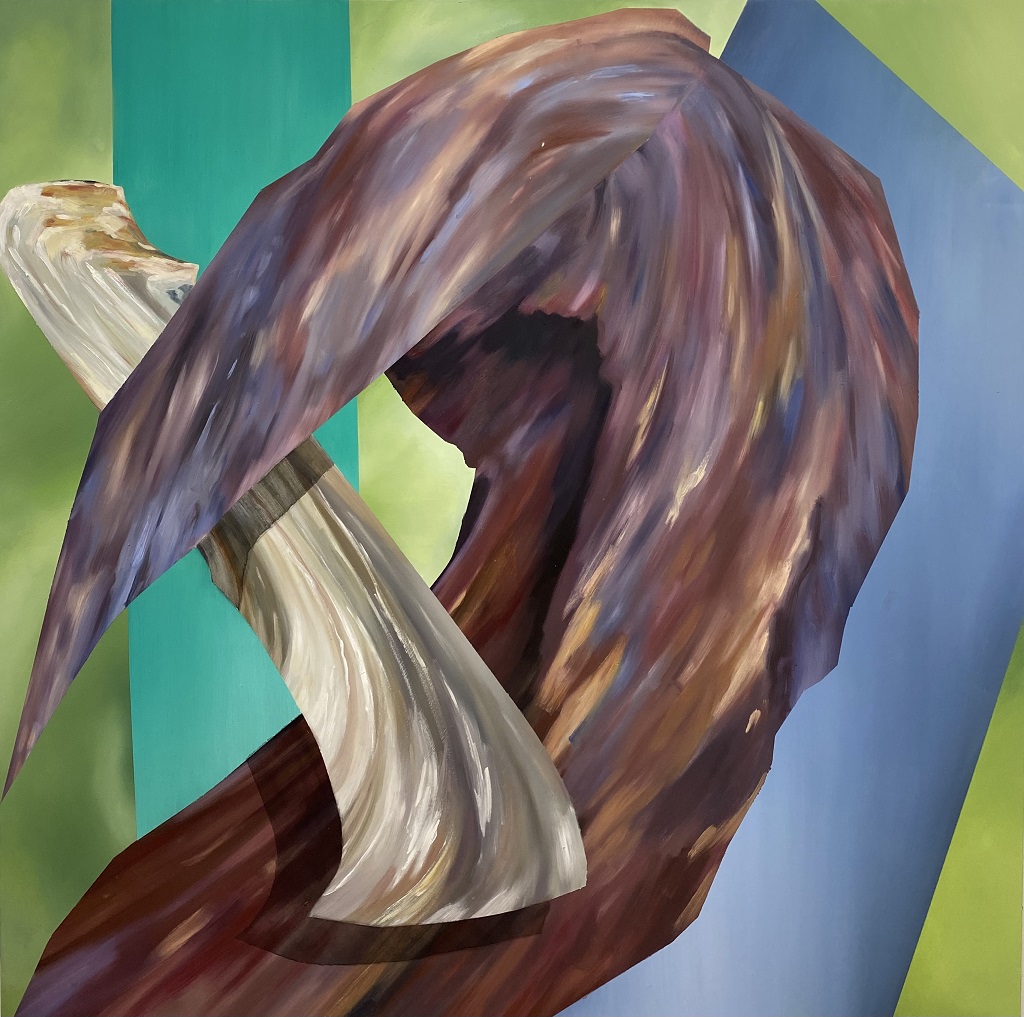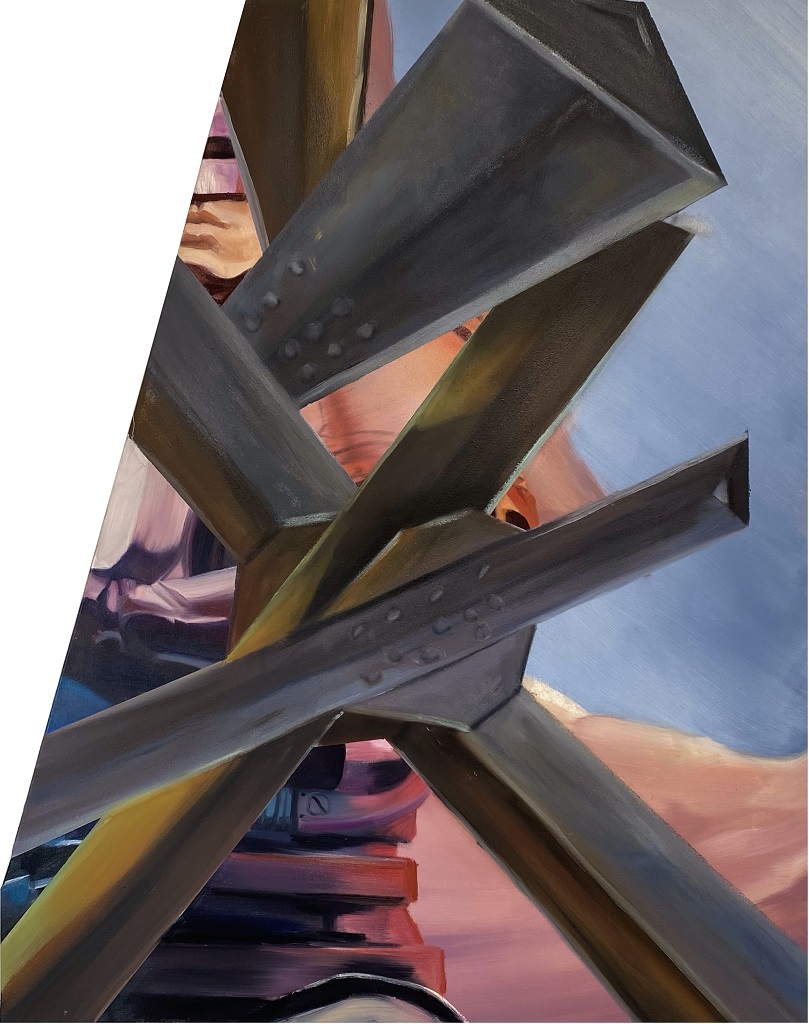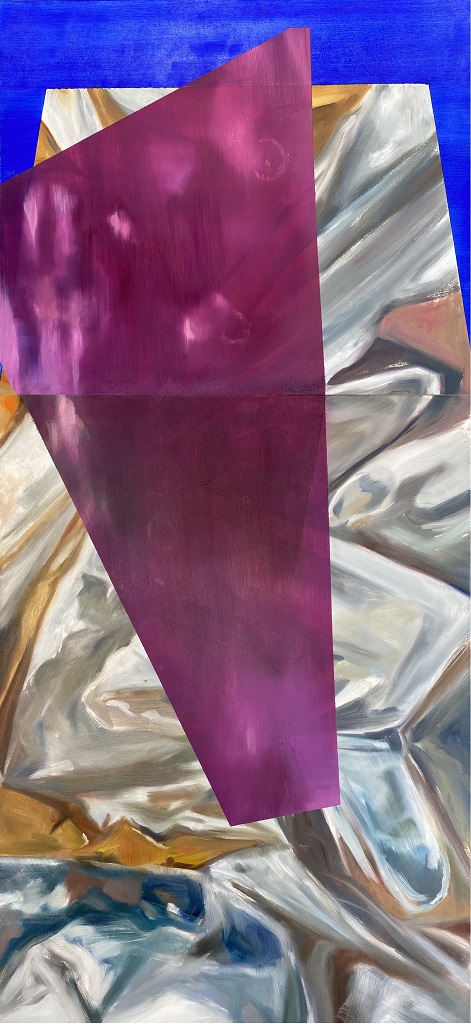Šarūnas Baltrukonis in conversation with Alberta Vengrytė
Contemporary art critic and historian Alberta Vengrytė talks with painter Šarūnas Baltrukonis about the vibration of surface and the balance between the vital and nonvital motifs in painting – the following discussion is based on the animation “Green Interlude” 2021.
Šarūnas Baltrukonis, Green Interlude, 2021
Animation by Medeinė Revuckaitė
ALBERTA VENGRYTĖ: The canvases you create combine the spaces of reality and digitality, but both are abstracted, when only certain fragments of them are recognizable – wedges of reality or virtuality, often characterized by urban and/or cybernetic aesthetics. In the end of 20th century – beginning of 21st century, when technologies established themselves as culturally dominant, the possibilities opened up as never before to freely manipulate essential socio-epistemic concepts, such as the self, body, space, time, memory, liveness, virtuality, nowness, documentality, etc. This is also evident in the aesthetics of your works. What is your relationship with technology as an artist? Could you describe the worldview in which the motifs of your paintings are born? What would you say if I asked you what you consider the technological identity of your paintings? Is it determined by the technique or the motive?
ŠARŪNAS BALTRUKONIS: I think technology and the nature of reality have an equal influence on my work. I belong to the generation that grew up with technology. As a result, I find the digital image naturally attractive and intimate. Creative motifs are often influenced by images reminiscent of virtuality. Sharp, strict lines, high contrast, smoothness of paint, its’ screeniness, clean colors. This essentially becomes the identity of my paintings, the desire to bring oil painting closer to aesthetics, which occupies a large part of my worldview. All this is revealed through the technical side of painting.
A.V.: In your works, the illusion of overlapping two-dimensional and three-dimensional images is prominent. For me, it also presupposes a specific problem of the forms belonging to the spaces of reality and virtuality, as an epistemological problem of changing knowledge about the structures “ontologically” belonging to these spaces. In other words, the motifs in your canvases seem to lose their ontological “realism” or “digitality” and enter into a qualitatively new relationship that can be understood through mutual interaction… Correct me if I‘m wrong, but it seems to me that it is the play of two-dimensional and three-dimensional planes here that represents the chiaroscuro of classical painting, deforming the unity of the elements belonging to the picture in relation to space and time. Movement is represented here by the brushstroke, and space by geometry? Could you describe the essential strategies of your painting?
Š.B.: From the contextual side, oil painting has always been accompanied by chiaroscuro, it is not an exception in my work, I think it is one of the more important features of the painting, but I feel that the traditional way of solving chiaroscuro would not have been appropriate here. Light and dark in my paintings is not based on logic and is subject to compositional input. I try to maneuver between flatness and spatiality, which results in the aforementioned deformation of the elements of the picture. With a brushstroke I not only try to show the implied movement, but also to strengthen the suggestiveness of the form.

Šarūnas Baltrukonis
Atlantis Wing, 2021
A.V.: One of the strongest components of your paintings is composition. Here again, elements belonging to the vital and non-vital spaces of reality are active. Fragments of nature motifs, as for example in the work “Green interlude”, acquire photographic, digital character, and other elements that create the overall composition of the picture, being clearly non-vital in nature, seem to adapt to hints of naturalness, but transform the solid horizon of the picture by creating an uncanny impression arising from these two different materials. What creative principles do you rely on when creating picture plots? The very concept of “plot” here seems to go beyond the classical limits of the term… In other words, the relationship between an abstract image and its ideological content does not leave me in peace here. How does this productive opposition help to reveal the complex forms of objects found in reality, which you reduce to fragments that actively interact with the elements of the picture belonging to the field of virtuality? What determines the choice of these motifs – the purpose of the objects or their visuality?
Š.B.: The selected motifs are primarily attractive for their visuality, if the texture is found in nature, its choice may be determined by the implied sense of touch: rough, sharp, smooth, slippery surfaces transmit their energy differently when touched, I try to transfer such a feeling to my works through the stroke of paint. I combine motifs that are opposite to each other and create a balance between them, with the applied painting load I create parameters for the motifs, which, by changing them, bring the originally heavy matter closer to its opposite – the lightness. I do the same with the nature of the motif. When painted, it loses its original digitality or realism and stays somewhere in between and betwixt the two.
A.V.: You experiment by deforming the canvas itself, cutting off part of the frame or choosing non-standard exposure angles. How does this correlate with the painterly strategies applied to the content of the paintings and the aesthetics of glitch (chromatic aberration)? How digital image distortion serves to convey the relationship between realism and digitality?
Š.B.: The digitality enters the reality, the canvas cut with the help of deformation can be a guide to an unloaded, stuck picture on the desktop. While changing the viewing angle, I reach a texture jamming in space, as happens in video games. In these ways, I try to extract the digital from the two-dimensional space hidden behind the screen and reimagine it in space. Such decisions also serve compositionally or can become the axis of the decision of the idea of the work.

Šarūnas Baltrukonis
Delayed heavy infantry, 2022
A.V.: When we talk about the overlap between reality and virtuality, we often think about a certain “collapse” of reality in the realm of virtuality. Such a feeling pervades a considerable part of the most famous cultural theoreticians of the 2nd half of the 20th Century. However, in the 3rd decade of the 21st Century we seem to increasingly abandon the overarching idea of a cultural dystopia in which, as i.e.. in the 1996 texts of Mark Dery, we are talking about the genderless and germless normative future, where the only link between the technocratic elite and the technologically illiterate masses is the shopping center – and we try to positively perceive the changing structures of knowledge about the aesthetic and socio-political planes of the work of art… When thinking about the prototypes and repetitions of the motifs of a painting, I remember the views belonging to the same discourse of “the death of human culture in the realm of virtuality”, as if the desire for self-referential simulations caused by the medialized cultural experience manifests itself in the fading need for any original. But isn’t it the case that we enjoy images precisely because they are not the real thing; we admire them for the skill with which they were crafted. Such pleasure presupposes that the readers or viewers of the artistic text do not fall prey to mimetic illusion; they do not stop realizing that the read or seen text is just a duplicate; that what causes fascination is merely the illusionistic visual effect, the artificiality of the artificial? I speak here through the lips of the Swiss-American theorist Marie Laure Ryan. These thoughts of hers seem to explain to me the duality of the motifs seen in your paintings – they are neither purely physical, nor technical, nor real, nor virtual, nor completely original, nor reproduced… What kind of thoughts does the idea that when looking at your works perhaps we enjoy the universal pleasure of recognizing otherness brings?
Š.B.: Strongly zoomed photos give me a similar feeling in photography. A fragment of a real object in nature loses its natural properties and only abstracted spots remain. A good example of this would be the photo series “iPhone zooming” by Viktorija Pidust, a photographer of Ukrainian origin. The artist makes us look at everyday objects closely and forget their primary function. I think that’s why I’m interested in texture, isolated surfaces taken out of context and interacting with each other begin to function in completely new ways. I believe it makes the piece more engaging and appealing.

Šarūnas Baltrukonis
Tilted Fever, 2021
A.V.: How does pictorial intimacy correlate with digital anonymity? One of the most beautiful moments of your work for me is precisely this seemingly simple contrast. The motif taken from the digital environment is reinterpreted and reborn on the canvas by the means of painting and handwork… Could you tell us more about your creative process? What a typical day looks like in your studio (or wherever you paint)?
Š.B.: The first work is born in the form of a sketch on the computer, where I make initial compositional decisions, plan the performance sequence and strategy. I often know in advance what painting technique I will use, this is where painterly intimacy emerges, which turns the digital image on the canvas into a cozy and close one through a thoughtful and specially adapted brushstroke. But sometimes, without any sketch, I start a work based on a photo and transform it in real time, with the help of chance, creating an initial layer that becomes a starting point for further planning of the painting. For new technical research, I perform compositional “exercises” which I call progression sessions. LTJ Bukem and MC Conrad’s live sets lasting a little more than an hour become a time to find a compositional solution, and the small format of the piece encourages to look for new ways of applying oil paint. The rhythm of drum and bass activates being in the zone, at the same time intuition takes over the steering wheel of creativity. Later, I reanalyze the painting and think about where I can use the things I learned in the future.
A.V.: During your studies, you met and started collaborating with the painter Mantas Valentukonis, as we speak, you are preparing for a joint exhibition at the Klaipėda Center for Cultural Communications. Although the visual expression of the two is different, the works function in a really close conceptual field. This summer, you also organized a painting “battle”, during which you painted on each other’s canvases (the result of this activity is the diptych “Don’t put too much water on a fire, put just the right amount of it, it creates warm vapors”). Is the authorship of the work important to you? What other artists would you like to collaborate with in the future? Perhaps you have artist-authorities?
Š.B.: It takes a lot of trust to achieve the level of collaboration that we have with Mantas. Here, not only professional, but also personal friendship helps. Having the same contextual foundation and approach to problem solving helps, too. However, collaboration does not necessarily have to be the kind we see in the aforementioned diptych. I have been thinking about a different kind of joint creation for some time now. Featuring artist- widely used in the music industry, could expand creative possibilities in visual art. The artist’s “inviting” to the author’s canvas, mixing two or more styles of visual expression would lead to unseen conceptual solutions. An excellent example of this can be seen in the painting of Vita Opolskytė Brazdžiūnienė, where her husband Kazimieras Brazdžiūnas’s pink armchair made with spray paint appears. This nature of such creation puts authorship in an uncertain position, which is why I think it is necessary to separate the author of the idea from its’ execution. The author of the idea becomes the “producer” of the picture, who fulfills his vision in the visual language of other artists. Personally, it would be an interesting challenge to create a painting with minimal or no physical input from me.
Inspiring artists: Johannes Bosisio, Volo Bevza, Victoria Pidust, Katarina Caserman, Manuel Resch, Maximilian Willeit, Andrius Zakarauskas, Gabriele Adomaitytė, Rutenė Merkliopaitė, Kazimieras Brazdžiūnas
